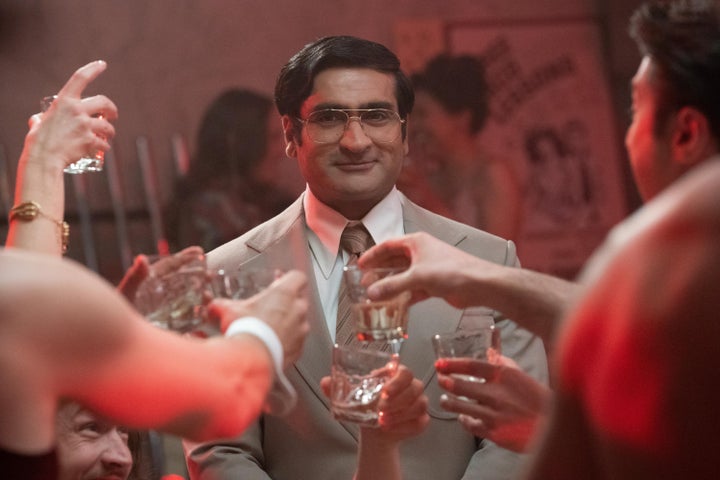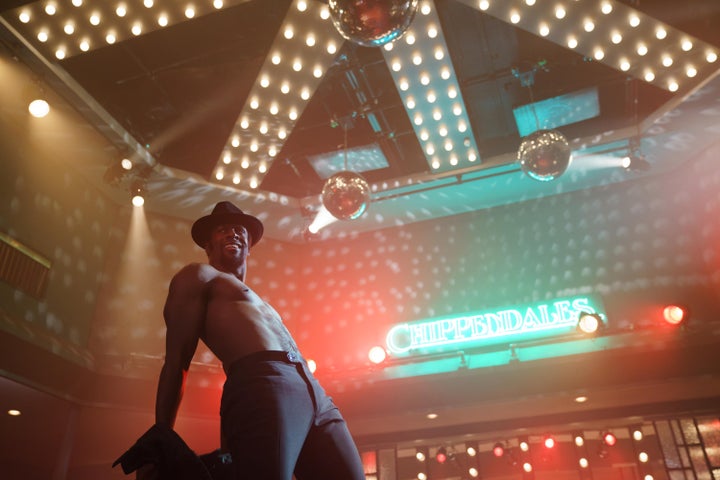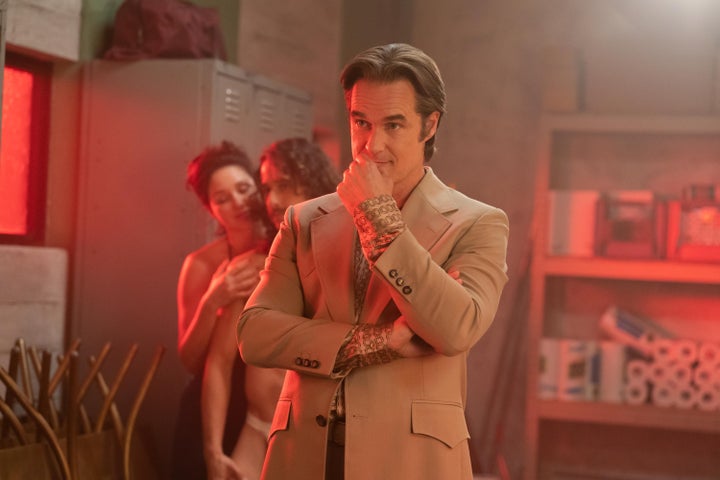Leave it to A&E to help bring back sensationalized true stories about sex and greed with its “Secrets of” series, which premiered early this year and includes “Secrets of Playboy” and “Secrets of the Chippendales Murders.” Both are tales of debauchery, sexuality as a proven business model, and the criminal men at the helm reaping all the financial benefits.
Even though the horrendous realities inside of the Playboy Club are ripe for a ripped-from-the-headlines-style dramatization, it’s the Chippendales saga that has enticed Hulu.
With “Welcome to Chippendales,” the platform invites audiences back to the ’80s and through the doors of the iconic male strip club owned by Somen Banerjee (Kumail Nanjiani), an Indian immigrant who came to the U.S. to achieve success and wealth.
Upon his rise to the top, deep-rooted insecurities and utter rage drive Somen, who changed his name to the American-assimilated “Steve,” to have choreographer Nick De Noia (Murray Bartlett) killed — and put a hit on several other competing clubs across the globe. When Steve is finally caught and sent to prison, he dies by suicide while awaiting sentencing.
Bettmann via Getty Images
That’s the well-documented who, what and how of this sordid story that, even 35 years later, sounds unimaginable.
The A&E docuseries takes a journalistic approach and cogently details each segment of the case, including Steve’s origins, his (sometimes racist) treatment of his dancers, and his toxic working relationship with his increasingly famous colleague Nick.
Through four one-hour episodes, the docuseries includes interviews with surviving family members of both Steve and Nick and a careful investigation of the crimes.
“Welcome to Chippendales,” which premieres on Hulu on Tuesday, takes a different approach, likely because it’s an eight-episode dramatization and portrayed by actors. Its commitment to telling a good story above anything else is evident right from the first episode.
That’s not to say that it’s bad or untruthful. It actually follows the real events fairly closely.

But the series, inspired by K. Scot Macdonald and Patrick MontesDeOca’s 2014 book “Deadly Dance: The Chippendales Murders,” also takes great leaps to ground some of the characters’ actions through human, recognizable motivations that sometimes come off contrived. Because all these years later, it’s probably still hard to say what really led to the mayhem.
That is profoundly evident in Steve’s narrative, far expanded from the story told in the A&E docuseries. Showrunners Jenni Konner and Robert Siegel take audiences deeper into his troubled story, featuring scenes with the grief-stricken mother he leaves behind in India only to learn that his search for greater success is seen as an insult to his family.
Steve is painfully uncool, a characteristic that makes him a social pariah ― save for his criminal partnership with Robin de Jesus’ Ray Colon (oddly portrayed as an outright sycophant in this series). That also means he’s unable to be the face of his own company, which gives him even more insecurities.
And it makes way for Nick, a very obvious, though talented, opportunist who immediately exploits Steve’s shortcomings and, in turn, meets his wrath.

“Welcome to Chippendales” also attempts to highlight the role of racism in Steve’s story, sometimes unsatisfactorily. The series shows how Steve faced intense prejudice as a brown immigrant in America, including a scene in which he and his wife, Irene (Annaleigh Ashford), are denied a table at a fancy restaurant.
That clearly had a more detrimental effect on his psyche than he might have let on.
But the series doesn’t offer the same razor-sharp exposition when it comes to Steve perpetuating similar racism toward his one Black dancer, Otis (Quentin Plair), the club’s most popular stripper, and ensuring that the all-white dancers translate to an all-white patronage.
It’s merely presented as a matter of fact; one that Plair’s character just isn’t prominent enough to fully confront.
Audiences could discern the hypocrisy and self-hatred that make up Steve’s character on their own, but the series doesn’t seem particularly interested in delving into that directly. He bolstered the same white supremacy he aimed to subvert just by his presence as a business owner in the extremely white sex industry in the ’80s that was largely dominated by figures like Hugh Hefner.
None of the facts in that sentence is sufficiently examined.

It’s the most recent example of an unsatisfying portrayal of race in a project Nanjiani is involved in. The previous instance was 2017’s “The Big Sick,” a solid romantic comedy that the actor stars in and co-wrote with his wife Emily V. Gordon. That film subtly upholds whiteness and mutes the experiences of people of color, which Nanjiani has since acknowledged.
Another pink elephant in “Welcome to Chippendales” is that it’s a story that in part tries to understand the role of racism, but Nanjiani is Pakistani American, not Indian American like Steve. Certainly, it’s significant that the actor is also an executive producer on the series and impressively captures both Steve’s humanity and his dysfunction.
But it doesn’t make the truth any less awkward.
There’s a similarly curious cultural change with Nick’s boyfriend, portrayed here as a white American by Andrew Rannells. In reality, Nick’s boyfriend was an immigrant whose relationship with him was kept hidden outside of those who knew Nick best.
That said, it’s nice that “Welcome to Chippendales” explores their relationship, in part because it gives us a look inside who Nick was beyond the smug, widely affable figure he’s often been purported to be. Bartlett, most recently known for his Emmy-winning turn on “The White Lotus,” gives him as much heart as he does cunning and drive.

While it’s assuredly the bane of Steve’s existence, it’s Nick’s allure that helps bring the Chippendales club alive in the series, along with its gloriously ’80s nightclub production design and costumes by Richard Bloom and Peggy A. Schnitzer, respectively.
It is Bartlett’s portrayal of Nick as the ultimate showman that guides us through the club and its players. That includes Nick’s friend and costume designer Denise (Juliette Lewis), an intriguing role that’s somewhat diminished from the docuseries, and Irene, who becomes the club’s beleaguered accountant.
“Welcome to Chippendales” deserves some credit for juggling themes that many other shows detailing the sex industry haven’t been bothered to broach, but some things are left to be desired that linger long after the final episode. Still, it’s a show amplified by a committed cast telling an otherwise compelling story that’s older than America itself: sex + money = power.
Now, to wait until the next platform or network gets its chance to tell it.


